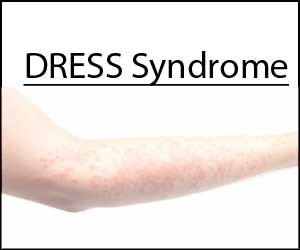- Home
- Editorial
- News
- Practice Guidelines
- Anesthesiology Guidelines
- Cancer Guidelines
- Cardiac Sciences Guidelines
- Critical Care Guidelines
- Dentistry Guidelines
- Dermatology Guidelines
- Diabetes and Endo Guidelines
- Diagnostics Guidelines
- ENT Guidelines
- Featured Practice Guidelines
- Gastroenterology Guidelines
- Geriatrics Guidelines
- Medicine Guidelines
- Nephrology Guidelines
- Neurosciences Guidelines
- Obs and Gynae Guidelines
- Ophthalmology Guidelines
- Orthopaedics Guidelines
- Paediatrics Guidelines
- Psychiatry Guidelines
- Pulmonology Guidelines
- Radiology Guidelines
- Surgery Guidelines
- Urology Guidelines
Rare case of Carbamazepine-induced DRESS Syndrome

Dr Sanjiv Maheshwari Professor, Department of Medicine, JLN Medical College, Ajmer, Rajasthan and colleagues have reported a case of Carbamazepine-induced DRESS Syndrome. The case has appeared in the Journal of Association of Physicians of India.
Carbamazepine is known as an anticonvulsant or anti-epileptic drug which is used extensively in clinical practice in varied indications and can cause adverse drug reaction showing diverse clinical manifestations of variable severity.
“Drug Reaction with Eosinophilia and Systemic Symptoms” (DRESS) syndrome is a severe, potentially life-threatening, acute adverse drug reactions, typically characterized by a long latency period from drug exposure. DRESS syndrome is characterized by the presence of fever, coetaneous eruptions, lymphadenopathy, internal organ involvement (such as hepatitis, carditis, interstitial nephritis, interstitial pneumonitis, etc.) and haematological abnormalities, mainly leucocytosis, eosinophilia, and sometimes atypical lymphocytosis. Diagnosis of DRESS is often delayed, as several diseases have clinical and laboratory features similar to DRESS syndrome
The authors have reported a clinical case of DRESS syndrome with liver injury, evaluated with the RegiSCAR scoring system as a “definite case” possibly induced by carbamazepine in a patient.
A 40-year-old male was admitted to hospital with a history of generalised swelling all over the body and reddish discolouration of skin associated with rashes for 2-3 days. The skin rash was accompanied by nausea, vomiting, fever up to 39.7 °C and Acetaminophen was taken as antipyretic. Approximately 2-3 months ago treatment with Carbamazepine for seizure disorder? (generalized tonic-clonic seizures). The patient's past, family, personal and drug histories were unremarkable.
Physical examination revealed a very weak pulse, with non-recordable blood pressure, axillary temperature of 38.8 °C, liver span of 14 cm and generalized non-tender lymphadenopathy. He had facial oedema, angular cheilitis and maculopapular exanthema progressing to exfoliative erythroderma. No clinical signs of herpes simplex infection provoked by fever were observed.
His ESR was 20 mm/1st hr., total leucocyte counts were 51.8 × 109 /L with lymphocytic predominance (47%) along with presence of atypical lymphocytes and moderate eosinophilia (11.5%). His routine biochemistry showed mild azotemia (blood urea – 91 mg/dl and serum creatinine – 1.4 mg/dl) and mild transaminitis (AST- 114 IU/L and ALT- 132 IU/L). His arterial blood gas analysis was unremarkable. Serological assays for hepatitis B and C virus, human immunodeficiency virus were negative.
Antinuclear antibodies were also negative. Blood, urine and stool cultures were negative. Chest radiography and electrocardiography were normal. Abdominal ultrasonography showed hepatomegaly with normal echotexture. Application of the RegiSCAR scoring system yielded a score of 8 and the clinical case was designated as a “definite case” of DRESS syndrome (Table 1). Carbamazepine was withdrawn immediately and patient was taken on sodium valproate, injection methylprednisolone, injection chlorpheniramine, and other supportive treatment. Monitoring of haematological and biochemical values was performed for the accurate management of DRESS syndrome. Patient improved and was discharged on 14th day along with a course of corticosteroids for 3 months duration with gradual tapering with regular follow-ups which were unremarkable.
For more details click on the link: http://www.japi.org

Disclaimer: This site is primarily intended for healthcare professionals. Any content/information on this website does not replace the advice of medical and/or health professionals and should not be construed as medical/diagnostic advice/endorsement or prescription. Use of this site is subject to our terms of use, privacy policy, advertisement policy. © 2020 Minerva Medical Treatment Pvt Ltd